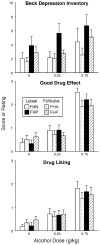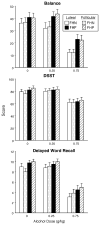Response to alcohol in women: role of the menstrual cycle and a family history of alcoholism
- PMID: 20888148
- PMCID: PMC3017640
- DOI: 10.1016/j.drugalcdep.2010.09.001
Response to alcohol in women: role of the menstrual cycle and a family history of alcoholism
Abstract
The present study determined whether: (1) the response to alcohol varied as a function of menstrual cycle phase and (2) women with a paternal history of alcoholism (FHP) were less sensitive to the effects of alcohol compared to women without a family history of alcoholism (FHN). The behavioral effects of alcohol (0.00, 0.25, and 0.75 g/kg) were evaluated in 21 FHN and 24 FHP women; each dose was tested during both the midfollicular and late luteal phases of the menstrual cycle. Baseline negative mood was increased during the luteal phase compared to the follicular phase (increased Beck Depression scores and decreased Vigor, Arousal, and Friendly scores). Alcohol increased ratings of Drug Liking and Good Drug Effect more in the luteal phase than the follicular phase. FHP women had greater negative mood during the luteal phase and some of these dysphoric effects were increased by alcohol more in FHP women than FHN women. Alcohol impaired performance, with no group or menstrual cycle differences. However, consistent with previous studies, FHP women were less impaired by alcohol than FHN women on the balance task. These data indicate that (1) the differences in response to alcohol across the menstrual cycle are subtle, although alcohol is liked more during the luteal phase; (2) increases in dysphoric mood during the luteal phase are more pronounced in FHP women compared to FHN women, particularly after alcohol; and (3) the differences observed in response to alcohol between FHP and FHN women are less pronounced than previously shown in men.
Copyright © 2010 Elsevier Ireland Ltd. All rights reserved.
Conflict of interest statement
All the authors declare that they have no conflicts of interest to report that could inappropriately influence, or be perceived to influence this work.
Figures





Similar articles
-
Response to alcohol in females with a paternal history of alcoholism.Psychopharmacology (Berl). 2003 Aug;169(1):10-20. doi: 10.1007/s00213-003-1474-2. Epub 2003 Apr 30. Psychopharmacology (Berl). 2003. PMID: 12721780 Clinical Trial.
-
Alcohol outcome expectancies and risk for alcohol use problems in women with and without a family history of alcoholism.Drug Alcohol Depend. 2003 May 21;70(2):201-14. doi: 10.1016/s0376-8716(03)00007-3. Drug Alcohol Depend. 2003. PMID: 12732414
-
Divided attention task performance and subjective effects following alcohol and placebo: differences between women with and without a family history of alcoholism.Drug Alcohol Depend. 1994 Apr;35(2):95-105. doi: 10.1016/0376-8716(94)90116-3. Drug Alcohol Depend. 1994. PMID: 8055741 Clinical Trial.
-
Alcohol and secobarbital effects as a function of familial alcoholism: extended intoxication and increased withdrawal effects.Alcohol Clin Exp Res. 1991 Feb;15(1):94-101. doi: 10.1111/j.1530-0277.1991.tb00524.x. Alcohol Clin Exp Res. 1991. PMID: 2024739 Clinical Trial.
-
Neurobiological phenotypes associated with a family history of alcoholism.Drug Alcohol Depend. 2016 Jan 1;158:8-21. doi: 10.1016/j.drugalcdep.2015.10.021. Epub 2015 Oct 21. Drug Alcohol Depend. 2016. PMID: 26559000 Free PMC article. Review.
Cited by
-
Ovarian hormones and borderline personality disorder features: Preliminary evidence for interactive effects of estradiol and progesterone.Biol Psychol. 2015 Jul;109:37-52. doi: 10.1016/j.biopsycho.2015.03.016. Epub 2015 Mar 30. Biol Psychol. 2015. PMID: 25837710 Free PMC article.
-
Fatal alcohol intoxication in women: a forensic autopsy study from Slovakia.BMC Public Health. 2011 Dec 14;11:924. doi: 10.1186/1471-2458-11-924. BMC Public Health. 2011. PMID: 22168833 Free PMC article.
-
Gabapentin increases the abuse liability of alcohol alone and in combination with oxycodone in participants with co-occurring opioid and alcohol use disorder.Pharmacol Biochem Behav. 2022 Nov;221:173482. doi: 10.1016/j.pbb.2022.173482. Epub 2022 Oct 13. Pharmacol Biochem Behav. 2022. PMID: 36244527 Free PMC article. Clinical Trial.
-
The relationship of appetitive, reproductive and posterior pituitary hormones to alcoholism and craving in humans.Neuropsychol Rev. 2012 Sep;22(3):211-28. doi: 10.1007/s11065-012-9209-y. Epub 2012 Jul 7. Neuropsychol Rev. 2012. PMID: 22772772 Free PMC article. Review.
-
Prenatal Stress Alters Progestogens to Mediate Susceptibility to Sex-Typical, Stress-Sensitive Disorders, such as Drug Abuse: A Review.Front Psychiatry. 2011 Oct 17;2:52. doi: 10.3389/fpsyt.2011.00052. eCollection 2011. Front Psychiatry. 2011. PMID: 22022315 Free PMC article.
References
-
- Ackerman RJ, Gondolf EW. Adult children of alcoholics: the effects of background and treatment on ACOA symptoms. Int J Addictions. 1991;26:1159–1172. - PubMed
-
- American Psychiatric Association. Diagnostic and Statistical Manual of Mental Disorders. 4. Washington, DC: US Department of Health and Human Services; 1994.
-
- Anda RF, Whitfield CL, Felitti VJ, Chapman D, Edwards VJ, Dube SR, Williamson DF. Adverse childhood experiences, alcoholic parents, and later risk of alcoholism and depression. Psychiatr Serv. 2002;53:1001–1009. - PubMed
-
- Beck AT, Steer RA, Ball R, Ranieri WF. Comparison of Beck Depression Inventories -IA and -II in Psychiatric Outpatients. J Pers Assess. 1996;67:588–597. - PubMed
-
- Capone C, Wood MD. Density of familial alcoholism and its effects on alcohol use and problems in college students. Alcohol Clin Exp Res. 2008;32:1451–1458. - PubMed
Publication types
MeSH terms
Substances
Grants and funding
LinkOut - more resources
Full Text Sources
Medical

